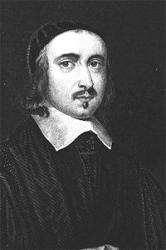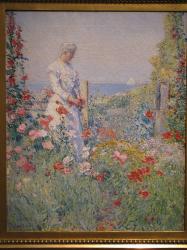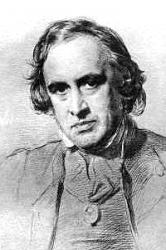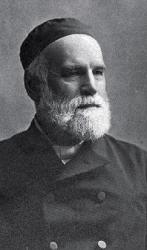Planning worship?
Check out our sister site, ZeteoSearch.org,
for 20+ additional resources related to your search.
- |
User Links
Person Results
Jeremy Taylor

1613 - 1667 Person Name: Bishop Jeremy Taylor (1613-1667) Meter: 10.10.10.10 Author of "Draw nigh to Thy Jerusalem, O Lord" in The Hymnal Taylor, Jeremy, D.D. This poet of preachers was born of very humble parentage on both sides, at Cambridge, in August, 1613. His father was a barber. He must have had a good school as a boy. He entered Cams College, of his native city, as a "sizar" in 1626. His career at the university was a brilliant one. He was made fellow of All Souls College, Oxford, in 1632; and rector of Uppingham, Rutlandshire, in 1638, as is still proudly remembered there. He was inevitably "sequestered" by Parliament in 1642. Inexorable necessities of circumstance put him in prison. During the opening of the great Protectorate he kept a school in Wales along with William Nicholson, and acted as chaplain to the Earl of Carberry at Golden Grove, Carmarthenshire, one of the pilgrim spots of our country, because of this and of his imperishable book named after it. In 1658 he is found in Ireland. He preached at Lisburn and Portmore. He returned to London early in 1660, and signed the loyalist or royalist Declaration of the Nobility and Gentry, on April 24th, thirty-five days before the "Restoration." He was not overlooked, as so many faithful royalists were. He was consecrated bishop of Down and Connor in January, 1661; made a member of the Irish Privy Council in February; entrusted with the diocese of Dromore in March: and in the same year was chosen Vice-chancellor of the University of Dublin. He died at Lisburn, August 13th, 1667, and was interred in the choir of the cathedral of Dromore.
Bishop Taylor's complete works have been repeatedly edited, e.g. by Henry Rogers, Pitman, Bishop Heber, Eden; and manifold Selections and single books, as his Holy Living and Holy Dying. Notwithstanding his rich and im¬perial intellect, and enthralling eloquence, and absolute command of words, Bishop Taylor holds only a very small place in the Antiphon of England. It has been admirably said by Dr. Rowland Williams, "Poetry differs from eloquence, as love differs from friendship" (Stray Thoughts, 1878). His attempts at verse are eloquence, not poetry, and even the eloquence hampered and shallowed. The present writer collected his entire poems and verse-translations in the Miscellanies of the Fuller Worthies' Library (1870). In the "Introduction" the reader will find a critical ac¬count of the various hymns; and also therein an account is furnished of a flagrant misap¬propriation of Bishop Taylor's Hymns by Samuel Speed in his Prison Piety, or Meditations divine and moral. Digested into poetical heads on mixt and various subjects (1677). The following is the original title page of the volume in which all the Festival Hymns, save one, first appeared:—>
The Golden Grove, or a Manuall of Daily Prayers and Letanies Fitted to the dayes of the Week. Containing a short Summary of what is to be Believed, Practised, Denied. Also Festival Hymns According to the manner of "The Ancient Church." Composed for the Use of the Devout, especially of Younger Persons; By the Author of "The Great Exemplar." London: Printed by J. F. for R. Rayston, at the Angel in Ivie Lane, 1655. (12 mo.) A 2nd edition appeared in 1657 with the Author's name thusBy Jer. Taylor, D.D., Chaplain in Ordinary to his late Majesty—a courageous announcement in the circumstances. A 3rd edition seems to have disappeared. The 4th ed. appeared in 1659; and from it is derived the second Christmas Hymn, “Awake, my soul," which was not in either the 1st or 2nd ed. Heber, Pitman, and Eden overlooked this hymn. [Rev. A. B. Grosart, D.D., LL.D.]
From Bishop Taylor's Golden Grove, 1655, the following hymns are in common use:--
1. Full of mercy, full of love. Prayer for Charity. From the Golden Grove, p. 116, where it is given in 20 lines, and headed, "A Prayer for Charity." It was given in Bishop Heber's posthumousHymns, &c, 1827, p. 109, and thus came into later hymnbooks.
2. Lord, come away, why dost Thou stay. Advent.
3. Lord, let Thy flames of holy charity. Whitsunday. This begins with line 12 of his hymn in the Golden Grove, "On the Feast of Pentecost, or Whitsunday," p. 157.
His Christmas Carol, "Where is this blessed Babe” and his Prayer, "My soul doth pant towards Thee," are also from the Golden Grove.
-- John Julian, Dictionary of Hymnology (1907)
Jeremy Taylor
Celia Thaxter

1835 - 1894 Meter: 10.10.10.10 Author of "Lift up thy light, O man, arise and shine" in Christian Science Hymnal (Rev. and enl.)
Celia Thaxter
Thomas H. Troeger

1945 - 2022 Person Name: Thomas H. Troeger, b. 1945 Meter: 10.10.10.10 Author of "Before the Fruit Is Ripened by the Sun" in Worship (4th ed.) Thomas Troeger (1945-2022), professor of Christian communication at Yale Divinity school, was a well known preacher, poet, and musician. He was a fellow of Silliman College, held a B.A. from Yale University; B.D. Colgate Rochester Divinity School; S.T. D. Dickinson College, and was awarded an honorary D.D. from Virginia Theological Seminary. He was ordained in the Presbyterian Church in 1970 and the Episcopal Church in 1999, and remained dually aligned with both traditions. Troerger led conferences and lectures in worship and preaching throughout North America, as well as in Denmark, Holland, Australia, Japan, and Africa. He served as national chaplain to the American Guild of Organists, and for at least three years he hosted the Season of Worship broadcast for Cokesbury. He was president of the Academy of Homiletics as well as Societas Homiletica. He had, as of 2009, written 22 books in the areas of preaching, poetry, hymnody, and worship. Many of his hymn texts are found in New Hymns for the Lectionary (Oxford, 1992), and God, You Made All Things for Singing (Oxford, 2009).
Laura de Jong
Thomas H. Troeger
Richard Chenevix Trench

1807 - 1886 Person Name: Richard Chenevix Trench, 1807 - 1886 Meter: 10.10.10.10 Author of "Lord, What a Change within Us" in Christian Youth Hymnal Trench, Richard Chenevix, D.D. was born in North Frederick Street, Dublin, on Sept. 9th, 1807, during a visit of his parents of some mouths to Ireland. His father was Richard Trench, 6th son of Frederick Trench, of Woodlands, Co. Galway; his mother Melesina, only grandchild and heiress of Richard Chenevix, Bishop of Waterford, and widow of Colonel St. George. On his mother's side he was almost purely French, the grandfather of Bishop Chenevix of Waterford, Philip Chenevix of d'Eply of Loraine having only taken refuge in England on the revocation of the Edict of Nantes. The Huguenot refugee families married for a long time within themselves, and in Mrs. Richard Trench, four distinct foreign strains were blended. Her sons (the Archbishop and his brothers, besides his two sisters) were the only descendants of the Refugee Philip, either in the male or female line, all the other branches having come to an end. Trench's home in childhood was Elm Lodge, close to the village of Bursledon, not far from Southampton. In February, 1816 he proceeded to Twyford School, and in 1819 to Harrow, where he won great distinction. In October 1825 he was entered at Trinity College, Cambridge. His mother's correspondence is full of references to a little periodical called The Translator, begun in 1825, or immediately on his becoming an undergraduate. She was his ardent co-worker both as contributor and critic. In 1826 he had acquired Spanish, and in that year applied himself to preparing and publishing a volume of Miscellanies, of which the "profits were to be sent to the committee formed for the relief of the exiled Spaniards." On May 27th, 1827, his mother died at Malvern. The Letters and Memorials (1888) give vivid and exciting details of his continuous interest and daring personal service and sacrifices on behalf of Spain. It was during the winter days of 1829-30 that the consultations and schemes respecting Spain were discussed in John Sterling's apartment. Robert Boyd, Trench's cousin, threw himself and his entire fortune into the plot by purchasing a small ship in the Thames and storing it with arms, in which General Torrijos and fifty picked Spaniards were to sail for the new adventure of the Golden Fleece. The enterprise ended tragically. Boyd and others perished by the inevitable vengeance of the Spanish sovereign when captured. By the hand of God, Trench was safe in Gibraltar.
Till far up in young manhood he was undecided as to his calling, Law rather than Divinity colouring his thoughts and plans. He left Cambridge on February 1st, 1829, and rejoined his widowed father at Elm Lodge, near Southampton. He married, at the Abbey Church, Bath, on May 31st, 1832, his own cousin, Frances Mary Trench, daughter of his uncle, Francis Trench (2nd son of Frederick Trench, of Woodlawn, co. Galway, Ireland, and next brother to the 1st Lord Ashtown). On October 7th, 1832, he received Deacon's Orders in Norwich Cathedral at the hands of the aged Bishop Bathurst of Norwich. His first curacy was at Hadleigh, Norfolk, with H. J. Rose. He was ordained priest early in July, 1835, by Bishop Sumner, of Winchester. He published in 1835 The Story of Justin Martyr, and other Poems (Moxon). This was (practically) his first book. In 1838 followed Sabbation, Honor Neale, and other Poems, with Notes. In 1840 appeared his first prose work, Notes on the Parables of our Lord, subsequently companioned with Notes on the Miracles of our Lord (1846). In 1841 "the loving discipline of pain" visited his heart and hearth by the death of his eldest born, a deep sorrow which gave its subtlest and finest inspiration to his Elegiac Poems. A third volume of poetry, Poems from Eastern Sources, the Steadfast Prince, and other Poems, was published early in 1842; and a fourth, Genoveva, later in the same year. Early in 1843 he delivered his Five Sermons before the University of Cambridge, published in 1844. In 1844 also was published Exposition of the Sermon on the Mount, drawn from the Writings of St. Augustine, with Observations. In this same year he became Vicar of Itchen Stoke.
In 1845 he delivered a lecture "On Language as an instrument of Knowledge," which expanded into his famous and suggestive Study of Words. In 1846 he was appointed Professor of Divinity at King's College, London, later changed into "Professor of the Exegesis of the New Testament,” which he held until 1858. The friendship between Trench and Maurice here was very beautiful. In 1846 also came the Hulsean Lectures, their subject being Christ "the Desire of all Nations." In 1849 appeared his Sacred Latin Poetry. This is an inestimable book. In 1852, Lessons on Proverbs and Study of Words, and in 1855 English Past and Present appeared. His Synonyms of the New Testament (1854) was a permanent contribution and inspiration to Philology and Theology. Life's Dream: the Great Theatre of the World, from the Spanish of Calderon, with an Essay on his Life and Genius, was published in 1856; 2nd ed. in 1880. The Crimean war drew from him his finest verse, Poems written during the Russian War (1854-55). In 1856 he was appointed Dean of Westminster. In 1861 was published his Commentary on the Epistles to the Seven Churches in Asia. On New Year's Day, 1864, he was consecrated Archbishop of Dublin in Christ Church Cathedral. He instantly took a foremost place in the regard of the entire community. His published Sermons, including his Studies on the Gospels (1867), are amongst the most thoughtful and quietly eloquent in our language; as are his Lectures on Plutarch (1873), and others. Timolem (1881) was his last poem. His final confirmation was in St. Bartholomew's Church on May 16th, 1884. On November 28th, 1884, he resigned his Archbishopric. He died in London, March 28, 1886. Few have left behind them a more stainless, a more loveable, a more enviable memory. He was sweetness and light embodied. [Rev. A. B. Grosart, D.D., LL.D]
In the strict sense of the word Archbishop Trench, although a poet, was not a hymn-writer. Some of his poetical pieces are used as hymns, but their use is limited. These include:—
1. High thoughts at first, and visions high. Ordination. Appeared in his Story of Justin Martyr, &c, 1835, p. 53, in 1 stanza of 8 lines, and entitled "To a Friend entering the Ministry." Its use as a hymn is in an abbreviated form.
2. I say to thee, do thou repeat. Safety in Divine Guidance. Published in his Story of Justin Martyr, &c, 1835, in 10 stanzas of 3 lines, again in his Poems, 1865, p. 98, and ed. 1885, i. p. 140. It is headed, "The Kingdom of God."
3. Let all men know that all men move. Love of God. Published in his Story of Justin Martyr, &c, 1835, p. 111.
4. Lord, weary of a painful way. Evening. Appeared in his Sabbation, Honor Neale, &c, 1838, p. 117; and Poems, 1885, i. p. 207.
5. Not Thou from us, 0 Lord, hut we. Divine Love. Published in his Story of Justin Martyr, &c, 1835, p. 52, in 14 1., and in his Poems, 1885, i. p. 109.
6. Pour forth the oil, pour boldly forth. The Law of Love. Appeared in his Sabbation, Honor Neale, and Other Poems, 1838, p. 132, in 5 stanzas of 4 lines, and entitled "The Law of Love," also in his Poems, 1865, p. 150, and ed. 1885, i. p. 215. From this is taken the hymn, Make channels for the stream of love."
7. Some murmur when their sky is clear. Contentment. Published in the Sabbation, Honor Neale, and Other Poems, 1838, p. 116, in 2 st. of 8 1., in his Poems, 1865, p. 113, and ed. 1885, i. p. 142.
8. Thou inevitable day. Death. From his Sabbation, Honor Neale, &c, 1838, p. 99, in 14 stanzas of 3 lines, and headed, "The Day of Death." Also in Poems, 1885, i. p. 213.
-- Excerpts from John Julian, Dictionary of Hymnology (1907)
Richard Chenevix Trench
Alfred Tennyson, Baron Tennyson

1809 - 1892 Person Name: Alfred Tennyson, 1809-1892 Meter: 10.10.10.10 Author of "Late, Late, so Late!" in The New Christian Hymnal Tennyson, Alfred, Lord, son of the Rev. G. C. Tennyson, Rector of Somersby, Lincolnshire, was born at Somersby, Aug. 6, 1809; educated at Trinity College, Cambridge; appointed Poet Laureate in 1850, and raised to the Peerage in 1884. Although Lord Tennyson has not written any hymns, extracts from his poems are sometimes used as such, as "Strong Son of God, immortal Love" (Faith in the Son of God), from the Introduction to his In Memoriam, 1850; the well-known "Too late, too late, ye cannot enter now," and others. The former is sometimes given as "Spirit of immortal Love," and again as "Eternal God, immortal Love."
--John Julian, Dictionary of Hymnology, Appendix, Part II (1907)
Alfred Tennyson, Baron Tennyson
Emily Taylor
1795 - 1872 Meter: 10.10.10.10 Author of "God of the Changing Year" in The Cyber Hymnal Taylor, Emily, born 1795, was the daughter of Samuel Taylor, of New Buckenham, Norfolk, niece of John Taylor, of Norwich, the hymnwriter, and great grand-daughter of Dr. John Taylor, the Hebraist. Miss Taylor was the writer of numerous tales for children, chiefly historical, and of various books of instruction, and of descriptive natural history. Amongst her publications are:—
(1) Letters to a Child on Maritime Discovery, 1820; (2) Vision of Las Casas, and other Poems, 1825; (3) Poetical Illustrations of Passages of Scripture, 1826 ; (4) Tales of the Saxons, 1832; (5) Tales of the English, 1833; (6) Memoir of Sir T. More, 1834; (7) The Boy and the Birds, 1835. She also edited Sabbath Recreations, 1826; and Flowers and Fruit in Old English Gardens, 1836; and contributed to the Magnet Stories, 1860, &c.; and the Rainbow Stories, 1870, &c.
Miss Taylor wrote several hymns, which appeared as follows:—To the Unitarian Collection of Psalms & Hymns, printed for the Renshaw Street Chapel, Liverpool, 1818, she contributed anonymously:—
1. Come to the house of prayer. Invitation to Public Worship. Sometimes given as "O come to the house of Prayer."
2. God of the changing year Whose arm of power. Lessons of the Changing Year.
3. O Father, though the anxious fear. Sunday.
4. O here, if ever, God of love. Holy Communion.
These, and the following 6 hymns, were given anonymously in the 2nd ed. of the Norwich Unitarian Hymn Book, 1826:—
5. Here, Lord, when at Thy Table met. Holy Communion.
6. O not for these alone I pray. Holy Communion. Sometimes, "No, not for these alone I pray."
7. The Gospel is the light. Worth and Power of the Gospel. Sometimes “It is the one true light."
8. Thus shalt thou love the Almighty God [Lord] . Self-consecration to God.
9. Who shall behold the King of kings? Purity.
10. Who that o'er many a barren part. Missions. Sometimes it begins with st. ii., "Thy kingdom come! The heathen lands."
Of the above No. 6 is part of a longer poem which was given in her Poetical Illustrations of Passages of Scripture, 1826. This work also contains:—
11. O Source of good! around me spread. Seek, and ye shall find.
12. Truly the light of morn is sweet. Early Piety.
13. When summer suns their radiance fling. Resignation with Praise.
In the Rev. J. R. Beard's Collection of Hymns for Public and Private Worship, 1837, several of the above are repeated, and also:—
14. If love, the noblest, purest, best. Communion with Jesus.
Of these 14 hymns 10 are in Dr. Martineau's Hymns, &c, 1840, and 9 in his Hymns, &c, 1873. Several are also found in other collections, as Horder's Congregational Hymns, 1881, and some American and other hymn-books. Although for the greater part of her life Miss Taylor was a Unitarian, latterly, under the influence of F. D. Maurice, she joined the Church of England She died in 1872. [Rev. Valentine D. Davis, B.A.]
-- John Julian, Dictionary of Hymnology (1907)
Emily Taylor
Noel Tredinnick
b. 1949 Person Name: Noël Tredinnick (born 1949) Meter: 10.10.10.10 Arranger of "GO FORTH" in Hymns for Today's Church (2nd ed.) Composer
Noel Tredinnick
George Lansing Taylor

1835 - 1903 Person Name: George L. Taylor Meter: 10.10.10.10 Author of "The Sea Is His" in The Cyber Hymnal Taylor, George Lansing, D.D., born at Skaneateles, N.Y., Feb. 13, 1835, graduated at Columbia College, 1861, D.D. from Syracuse, 1876. Entered the Methodist Episcopal Ministry in 1862. His hymn, "Dare to do right! dare to be true" (Christian Courage), appeared anonymously in W. B. Bradbury's Golden Censer, 1864; and Bradbury's Clarion, 1867, as by "Rev. Geo. Lansing Taylor." In the Sunday School Hymnary , 1905 [Rev. James Mearns, M.A.]
--John Julian, Dictionary of Hymnology, New Supplement (1907)
============================
Taylor, George Lansing, D.D. (February 13, 1835-- ). Dr. Taylor spent two years at Ohio Wesleyan University before entering Columbia University. While a student at Columbia he was co-editor of the Christian Advocate and Journal and of The American Monthly. He preached for a number of years at various points in New England.
--Robert G. McCutchan, DNAH Archives
George Lansing Taylor
John Thornburg
b. 1954 Meter: 10.10.10.10 Author of "Gracious Creator of Sea and of Land" in Worship and Song
John Thornburg
Georgiana M. Taylor
1857 - 1914 Meter: 10.10.10.10 Author of "He Gave Himself" in The Cyber Hymnal
Georgiana M. Taylor


 My Starred Hymns
My Starred Hymns


